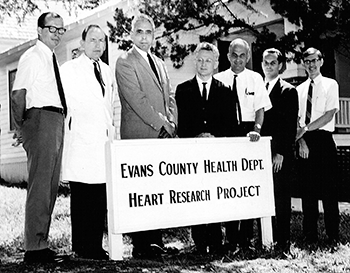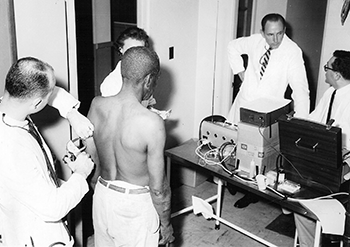Dr. Curtis G. Hames, Sr.'s clinical observations of the occurrence of coronary artery disease in his clinical practice were evaluated in the historic Evans County Heart Study. This was the first National Institutes of Health-sponsored epidemiological project to evaluate cardiovascular disease in the entire population of a bi-racially diverse community.

NIH's Dr. James Watt and Dr. Jeremiah Stamler of the Chicago Prevention and Evaluation Program recognized the potential of this community-based study proposal in Evans County, Ga., and Dr. Watt nurtured and expanded its scope. Dr. Hames secured the collaboration initially of Dr. John McDonough, a medical officer of the U.S. Public Health Service, the local Health Department, Dr. Glen E. Garrison of the U.S. Public Health Service and later the Department of Epidemiology and Biostatistics at the University of North Carolina School of Public Health. These collaborations directed the exploration of ethnic differences and causes of coronary artery disease in this small rural southern community and provided study design, and statistical, evaluation and administrative support as well as a funding mechanism.
The Evans County Heart Study began in 1959 when Dr. McDonough initiated a private census of Evans County to determine eligible residents for the study. The goal of the census was to identify all county residents above the age of 40 and a 50% sample of county residents between the ages of 15 and 39. Ninety- two percent(3,102) of eligible residents agreed to participate in the study and received a physical examination, a 12-lead electrocardiogram, serum-cholesterol determination and other biochemical studies. Frozen serum was banked for future research studies. The high study participation rate and that of other follow-up studies of this cohort was based on the excellent rapport Dr. Hames had with the residents of his community. Dr. Garrison who later joined the faculty of the Medical College of Georgia, and Dr. McDonough who joined the departments of Medicine and Epidemiology and Biostatistics at UNC examined and evaluated all participants in the initial Evans County Heart Study.

Data collected and analyzed in the original Evans County Heart Study confirmed Dr. Hames' initial clinical observations. After examining several factors, Drs. Hames, McDonough and Garrison and other researchers from UNC suggested that social status and physical exercise may contribute to ethnic differences observed in coronary artery disease in the county. Drs. Cassel, H.A. Tyroler and others from UNC along with Dr. Hames postulated in follow-up studies behavioral and environmental determinants of serum cholesterol in families with different social and occupational strata in Evans County. Other funded studies of the original and living members of the cohort continued over an ensuing 37 years.
Questions that emerged from his clinical observations, his initiative to establish the Evans County Heart Study and other collaborations established Dr. Hames as one of the pioneers of practice-based research and its networks. The rich database of the Evans County Heart Study has been used nationally and internationally for collaborative research resulting in multiple authored publications and citations exploring subjects such as:
 Passive smoking and 20-year cardiovascular disease mortality among nonsmoking wives
Passive smoking and 20-year cardiovascular disease mortality among nonsmoking wives...Curtis G. Hames, Sr., M.D. the Physician
...Curtis G. Hames, Sr., M.D. the Humanitarian